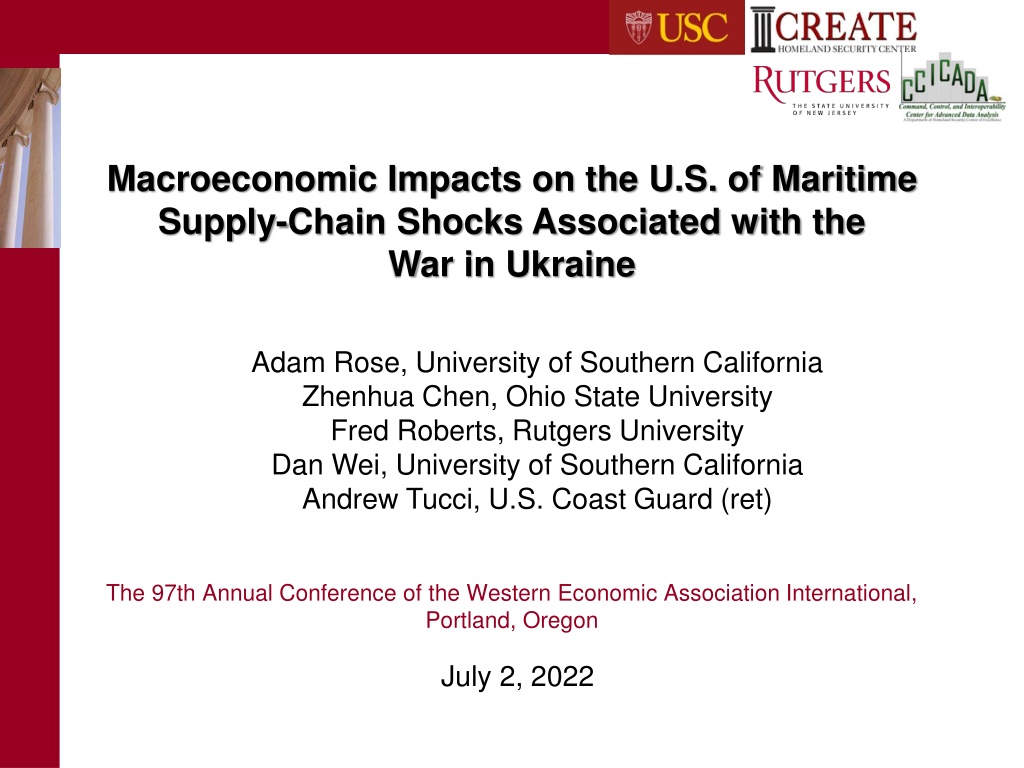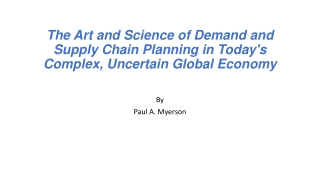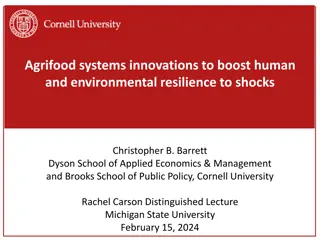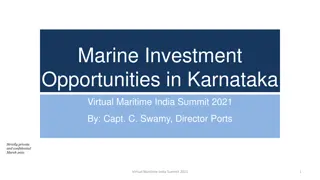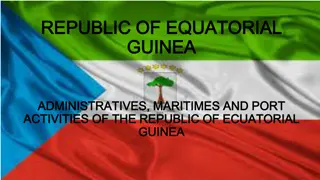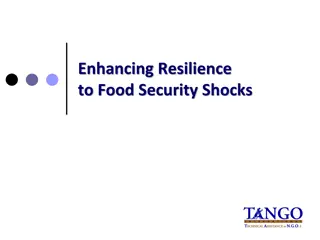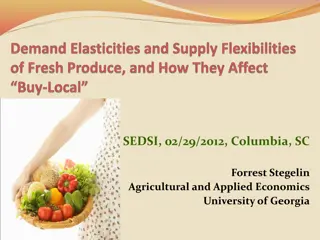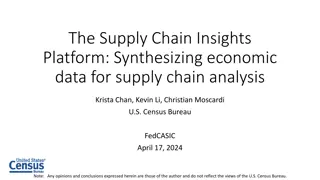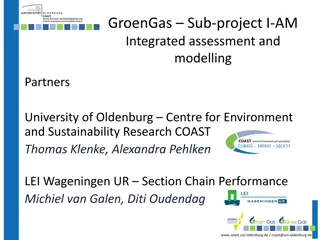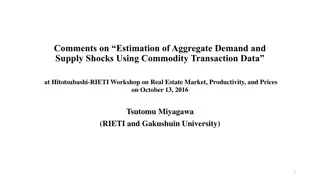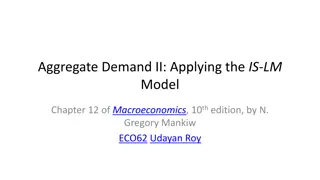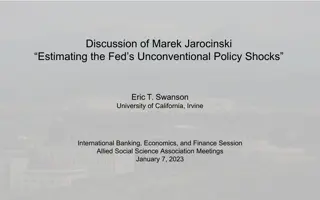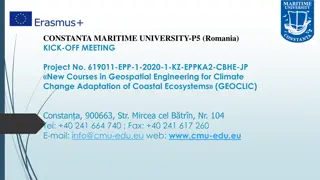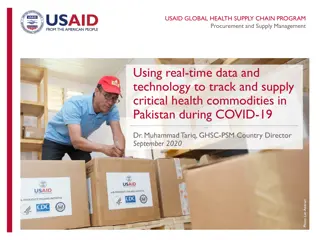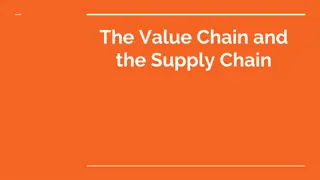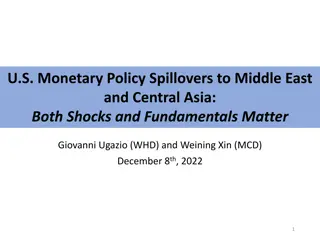Macroeconomic Impacts on the U.S. of Maritime Supply-Chain Shocks Associated with the War in Ukraine
Macroeconomic impacts of the Ukraine War on the U.S. maritime supply chain highlighted with disruptions in global markets for commodities like grains and metals. Analysis includes challenges faced due to the war and the cascading effects on the economy.
Download Presentation

Please find below an Image/Link to download the presentation.
The content on the website is provided AS IS for your information and personal use only. It may not be sold, licensed, or shared on other websites without obtaining consent from the author. Download presentation by click this link. If you encounter any issues during the download, it is possible that the publisher has removed the file from their server.
E N D
Presentation Transcript
Macroeconomic Impacts on the U.S. of Maritime Supply-Chain Shocks Associated with the War in Ukraine Adam Rose, University of Southern California Zhenhua Chen, Ohio State University Fred Roberts, Rutgers University Dan Wei, University of Southern California Andrew Tucci, U.S. Coast Guard (ret) The 97th Annual Conference of the Western Economic Association International, Portland, Oregon July 2, 2022
Presentation Outline Background Literature Review Data The GTAP Model Results Conclusions 2
Background COVID pandemic: Disrupted supply chains Forms the backdrop for the major economic challenges we face today, including inflation Situation exacerbated by: Shortages of shipping containers Backlogs in ports Switch to just-in-case stockpiling instead of just-in-time Grounding of the container ship Ever Given in the Suez Canal in March would have been bad enough, but was made much worse because it happened in the context of these other disruptions. Very little study of complex, multi-vector disruptions, and their cascading economic impacts. 3
Background Complex disruptions have cascading effects much worse than the sum of the effects of the individual disruptions. We started studying such complex disruptions Building scenarios Describing the economic sectors they impact Studying potential mitigations Building a user-friendly tool for estimating cascading impacts Then along came the Ukraine War A major disruption occurring in the context of already major economic disruptions. 4
Background Ukraine War is already having an impact on global markets for major commodities Grains, Metals, Energy products Grains: In 2021, 11.4% of global corn exports and 8.5% of global wheat exports originated from Ukraine In 2021, 13.1% of global wheat exports originated from Russia Prior to the War, in excess of 90% of Ukrainian agricultural exports were shipped from the country s Black Sea ports - currently impossible Possibility of moving goods by river barge, rail, or truck is limited. Moreover, as much as 20% of Ukraine winter crops may not be harvested 5
Background Metals Concerns about access to Russian platinum and other critical minerals - sanctions In 2021, Russia was the fourth-largest exporter of unwrought or semi-manufactured platinum and other precious metals Metals are at the front-end of long-supply-chain linkages Leading to key manufactured goods such as pig iron, unfinished steel, steel products and catalytic converters for automobiles. Our purpose: analyze the impacts of disruption of exports of grains and metals from Russia and Ukraine on the economy of the US and the world First step in a broader study of other impacts of the Ukraine War within the context of other disruptions to the marine transportation system. 6
Regional and Sector Classifications The analysis classifies the world into the following 17 regions: USA, Rest of North America, China, Japan, India, Rest of Asia, Canada, Latin America, Oceania, NATO countries (except the US and Canada), Rest of Europe, Russia, Rest of the Former Soviet Union, Ukraine, Middle East, Africa, and Rest of World Sectors include: Paddy rice Grains and Crops Vegetables, fruit, nuts, sugar Oil Gas Mining and Extraction Metals and Metal Products Ferrous metals Computer, electronic and optic Electrical equipment OtherManufacturing Vehicle Manufacturing Electricity Gas manufacture, distribution Water Construction Trade Tourism Transport nec Water Transport Oil Seeds Plant-based fibers and Crops Processed Food Livestock and Meat Products Textiles and Clothing Raw milk Other Livestock and Meat Produ Forestry Fishing Coal Vegetable oils and fats Air Transport Warehousing and support activi Communication Other Services Public Administration and defe Wood products Paper products, publishing Petroleum, coal products ChemRubber Basic pharmaceutical products Education Human health and social work a Dwellings 7
Export Data Data source: United Nations Commodity Trade Statistics Database Provides import and export data for over 200 countries and areas from 1962 to most recent year Data are collected from country statistical authorities and are standardized by the UN Statistics Division Trade data available at 2-, 4-, 6-digit HS commodity levels For each type of commodity, provides information on trade value, weight, reporter country, trading partner country, etc. Simulations of export disruptions include all 4-digit HS level grain and metal commodities that Ukraine and Russia combined represents over 10% of total global export value 8
Ukraine and Russia Grain Exports in 2020 Ukraine Percentag e of World Total Russia Percentag e of World Total 17.7% Global Export Value (M$) 44,796 Ukraine Export Value (M$) Russia Export Value (M$) HS Code Commodity Wheat and meslin Rye Barley Oats Maize (corn) Rice Grain sorghum Buckwheat, millet and canary seeds; other cereals Sun-flower seed, safflower or cotton-seed oil Source: United Nations Statistics Division (2022). 3,594 8.0% 0.6% 11.9% 0.4% 13.3% 0.0% 1.2% 7,918 1001 1002 1003 1004 1005 1006 1007 3 2 0.4% 12.2% 1.6% 1.1% 0.3% 0.2% 449 878 899 15 395 67 7,367 907 36,713 25,463 1,709 3 4,885 4 21 4 30 2.5% 41 3.4% 1,187 1008 5,320 40.0% 2,472 18.6% 13,316 1512 9
Ukraine and Russia Metal Exports in 2020 Ukraine Export Value (M$) Ukraine Percentage of World Total Russia Export Value (M$) Russia Percentag e of World Total Global Export Value (M$) HS Code Commodity 7110Platinum, unwrought or in semi-manufactured forms 72 Iron and steel 74 Copper and articles thereof 75 Nickel and articles thereof 76Aluminum and articles thereof 78 Lead and articles thereof 79 Zinc and articles thereof 80 Tin; articles thereof 81 Metals; and articles thereof 3 0.0% 7,842 12.3% 63,637 7,687 2.4% 0.1% 0.0% 16,006 5,647 3,024 5.0% 3.8% 13.8% 317,569 148,571 21,939 86 3 108 0.1% 5,464 3.4% 160,684 25 0 0 63 0.4% 0.0% 0.0% 0.4% 174 39 13 709 2.9% 0.3% 0.3% 5.0% 6,095 14,648 4,226 14,312 Note: Since there are more than 100 4-digit level metal commodities, data are presented at 2-digit HS level in the table (except for Platinum). Source: United Nations Statistics Division (2022). 10
GTAP Model The standard GTAP Model is a multi-region, multi- sector, computable general equilibrium model, with perfect competition and constant returns to scale Some unique features of the model include: The treatment of private household preferences using the non- homothetic CDE functional form. The explicit treatment of international trade and transport margins. Bilateral trade is handled via the Armington assumption. A global banking sector which intermediates between global savings and consumption. Provides a wide range of closure options, including unemployment, tax revenue replacement and fixed trade balance closures 11
Modeling Structure Possibility of a non-diagonal make matrix. Imperfect substitution is enabled through a substitution elasticity Production structure is based on a sequence of nested Constant Elasticity of Substitution (CES) functions Other Components Circular flows in a regional economy The model has a single representative household for each region. The household receives all gross factor payments net of the capital depreciation allowance, plus the receipts from all indirect taxes Regional income is distributed across three categories private consumption, public expenditures and saving. The top-level utility function of expenditure is specified in Cobb-Douglas format Consumption is specified differently for different agents (private Constant- Differences-of-Elasticities; gov CES/CD format) 12
Scenarios and CGE Shocks The simulations were implemented by the phantom tax shock mechanism to model the impact of the War on supply-chain disruption by restricting export volume from Ukraine and Russia, respectively, while maintaining zero profit and zero government revenue conditions through endogenizing the export tax or subsidy. The simulations were implemented in four groups, with variations of lower- bound and upper-bound for the following cases, respectively: Constraining the export volumes of five grain and metal products related sectors from Ukraine (goods exported from Ukraine to other regions/countries); Constraining the export volumes of five grain and metal products related sectors from Russia (goods exported from Russia to other regions/countries); The inputs of CGE simulation were based on Tables in Appendix 1 13
Real GDP Impacts of Export Reduction in Grains and Metal Commodities from the Ukraine-Russia War (in millions of 2014 U.S. dollars) Scenario Case Export Reduction from Ukraine Lower-Bound quantity change change 2 0 -5.5 -0.0004 -138 -0.0013 15 0.0003 188.5 0.0092 -414.5 -0.0081 13.4 0.0008 48 0.0009 48 0.0028 Export Reduction from Russia Lower-Bound quantity change change -26 -0.0001 -24.3 -0.0019 27 0.0003 83 0.0018 27.3 0.0013 -228 -0.0045 4.8 0.0003 54.5 0.0011 33.9 0.002 Upper-Bound quantity change 4 -9.1 -429 22 403.9 -906.5 34.9 114 125.8 Upper-Bound quantity change -58 -53.5 43 171 46.3 -503 13 116 73.9 percent percent change percent percent change -0.0003 -0.0041 0.0004 0.0037 0.0023 -0.0099 0.0007 0.0023 0.0043 Region 0 USA Rest of North America China Japan India Rest of Asia Canada Latin America Oceania NATO countries (except US and Canada) Rest of Europe Russia RFSU Ukraine Mid-East Africa Rest of World -0.0007 -0.004 0.0005 0.0198 -0.0178 0.002 0.0022 0.0074 -34 -0.0002 -122 -0.0007 40 0.0002 2 0 23.5 -144.8 -0.0071 -51.1 -0.0095 -1596.1 12 -14 -0.0006 0.002 0.001 45.8 -366.9 -116.4 -7301.93 34.75 -18.5 0.004 0.0019 -0.0181 -0.0216 -5.54 0.0013 -0.0008 0.0024 11 0.0005 0.0034 -0.0081 0.0061 -0.0027 -0.0025 0.0028 20 0.0008 -0.1201 -0.0174 0.004 -0.0056 -0.0055 0.0059 68.9 -43.7 8.0 -73.8 -62.8 0.005 -2440.1 -93.5 -1.211 0.0004 5.3 -156 -135.8 0.010 0.0011 14
CGE Results Impacts on Economic Welfare due to Grain and Metal Export Reductions from the Ukraine-Russia War (in millions of 2014 U.S. dollars) Scenario Case USA Rest of North America China Japan India Rest of Asia Canada Latin America Oceania NATO countries (except US and Canada) Rest of Europe Russia Rest of Former Soviet Union Ukraine Mid-East Africa Rest of World Total EV Ukraine Export Reduction Shock Lower-Bound 307.41 31.41 -1136.17 60.03 214.71 -490.52 91.82 360.45 276.19 Russia Export Reduction Shock Lower-Bound -164.04 46.66 -338.69 685.53 140.83 -383.24 -71.88 304.94 148.93 Upper-Bound 712.63 Upper-Bound -336.03 75.58 90.66 -790.15 1394.01 250.22 -846.23 -117.75 705.48 342.31 -3266.39 12.64 427.27 -1129.37 236.22 890.13 739.55 -424.95 55.80 53.29 53.52 -741.04 -453.03 -289.21 0.00 -2030.27 -1151.15 99.49 280.95 133.61 -4110.67 -903.01 -536.44 0.01 -7488.94 -470.42 -64.99 2483.84 -225.77 163.33 -1520.35 -825.67 -1290.89 -137.27 2781.13 -437.06 299.29 -3115.49 -1712.44 0.01 -90.99 0.02 -2920.18 15
Cascading Impacts on Different Trading Partners due to Grain and Metal Export Reductions from Russia (Upper-Bound 10 5 0 -5 Percent Change -10 -15 -20 -25 -30 -35 GrainsCrops FerrousMetal -40 Cascading Impacts on Different Sectors due to Grain and Metal Export Reductions from Russia (Upper-Bound) 20 10 0 Percent Change MeatLstk PetrCoalProd GasDistri PlantCrops Rawmilk OthMeatLstk OilSeeds TextWapp GrainsCrops VegOilFats ProcFood PublicAdm Oil WoodProd Construction OtherMaf VehicleMaf Trade Fishing Extraction FerrousMetal ATP MetalProd ELE Water Education Gas ChemRubber WTP Forestry PaperProd Electricity Tourism Health PaddyRice BPhaProd Elequip Communi Coal Dwellings OthServices TransportNec Warehousing VegSugCrops -10 -20 -30 16 -40
Conclusions Key Findings The Ukrainian economy is estimated to experience the most negative impacts, with a real GDP (GDP Quantity) reduction of 1.2% 5.54% (from Scenario of Ukrainian export shocks) Other countries/regions, such as Russia, China, Rest of Former Soviet Union (RFSU), and the Rest of Asia, are estimated to also experience relatively significant reductions in GDP Limitations and future Research The model behaves as if there is perfect foresight, where Russia knows that their exports will be sanctioned. Thus, rather than producing them and having them sit in warehouses or on seaport docks, they shift their resources to other productions at the beginning of the war. The more realistic situation is that much of the grains and metals have already been produced (and will have to sit in warehouses and on docks), and there are no spare resources to shift to other production. Our analysis is overly optimistic about the Russian outcome. The true outcome is likely to be somewhere between these two cases (Russians make an adjustment after a couple of months of the war), but is likely closer to the upper-bound scenario. We are currently working on modeling this in-between case. 17
Input Data Table 1A. Disruptions of Grain and Metal Exports from Ukraine Upper-Bound Vegetable Oils and Fats Value ($) Metals and Metal Products Grains and Crops Minerals nec Ferrous metals Commodity Value ($) Percent Value ($) Percent Percent Value ($) Percent Value ($) Percent 0 0.00% 29,150,904 62.20% 50,620,505 89.60% 0 0.00% 485,493,052 80.80% USA 5,507,290 90.00% 0 0.00% 2,329,906 90.00% 0 0.00% 0 0.00% Rest of North America 1,668,311,026 89.90% 2,242,724,311 89.40% 873,862,394 54.80% 0 0.00% 468,176,453 76.60% China 6,345 12.10% 43,930,725 86.30% 5,831,254 90.00% 0 0.00% 0 0.00% Japan 1,380,943 50.20% 8,030,716 39.20% 1,293,727,428 86.70% 0 0.00% 4,292,663 15.80% India 1,638,692,444 89.60% 50,231,343 68.40% 148,181,835 70.70% 0 0.00% 217,895,727 64.50% Rest of Asia 2,499,178 70.70% 0 0.00% 2,742,417 89.00% 0 0.00% 8,640,414 67.10% Canada 5,652,623 87.70% 15,190 0.80% 16,916,248 81.40% 0 0.00% 203,563,165 75.00% Latin America 405,552 72.10% 0 0.00% 23,710,887 89.90% 0 0.00% 671 0.00% Oceania NATO countries (except US and Canada) Rest of Europe 62.90%2,518,08 1,920,858,181 88.80% 1,058,654,912 75.00% 1,534,774,735 0.33% 2,132,647,153 58.20% 8 92,789,118 89.30% 316,051,628 89.00% 18,647,025 54.50% 0 0.00% 76,648,913 46.40% 0 0.00% 1,091 0.00% 221 0.00% 416,180 0.11% 128,396,465 24.40% Russia Rest of Former Soviet Union Ukraine Middle East 19,574,889 82.00% 2,159,529 6.30% 24,521,908 9.90% 35,250 0.01% 81,312,027 25.80% 0 0.00% 89.20% 0 0.00% 0.10% 0 0.00% 82.90% 0 0 0.00% 0.00% 0 0.00% 60.10% 994,153,300 5,993 573,685,271 512,545,480 2,071,383,453 89.90% 0.00% 64,427,977 73.30% 0.00% 218,337,738 65.60% 0.00% 66.90%2,969,51 0 0 0.00% 0.00% 467,009,262 55.60% 0.00% Africa Rest of World 0 0 0 0 8,421,214,342 89.50% 3,815,384,319 80.60% 4,787,889,772 0.17% 4,786,621,445 58.10% Total 9 19
Input Data Table 1B. Disruptions of Grain and Metal Exports from Russia Upper-Bound Grains and Crops Value ($) Minerals nec Value ($) 15,243,323 Vegetable Oils and Fats Value ($) 319,468 0 31.3% 507,812,236 18.6% 1,601,809 0.0% 300,130,919 8.1% 115,334,762 0.0% 30,900 56.0% 219,385 0.0% 1,161,239 Metals and Metal Products Value ($) 64.5%1,877,693,126 0.0% 46.2% 14,834,937 87.4% 979,172,682 82.0% 677,372,927 75.2% 230,540,312 75.0% 34.2% 61.6% Ferrous metals Value ($) 468,368,765 570,097,257 727,828,535 10,243,962 484,904 20.9% 1,972,092,250 0.0% 0.0% 99,663,633 0.0% Commodity Percent Percent Percent Percent Percent 76.1% 79.8% 84.0% 7.4% 0.2% 71.2% 0.0% 67.3% 0.0% 0 0.0% 90.0% 74.4% 793,841,333 68.4% 20,999,653 0.0% 89.3% 11,204,799 0.0% 90.0% 29,257,934 0.0% 60.9% 0.0% 69.7% 0.0% 0.7% 58.7% 58.1% USA Rest of North America China Japan India Rest of Asia Canada Latin America Oceania NATO countries (except US and Canada) Rest of Europe Russia Rest of Former Soviet Union Ukraine Middle East Africa Rest of World 17,836,685 37,452,809 11,746,066 0 0 0 0 1,155,012,572 0 0 0 0 0 0 63,070,990 0 0 0 1,915,286,012 89.1% 620,556,702 58.7% 429,807,968 31.4%4,067,894,855 13.9% 3,238,139,442 50.6% 36,013,625 88.8% 0.0% 56,961,255 39.8% 0.0% 19,182,794 21.6%1,821,707,673 0.0% 55.8% 0.0% 40,523,432 15.4% 0.0% 0 0 0 0 0 586,361,398 89.3% 1,266,985 0.2% 518,036,209 54.5% 21,000,929 0.6% 869,833,155 19.4% 5,645,048 1,230,024,410 3,232,734,084 44.3% 182,066,613 89.8% 90.0% 48,545,232 0.0% 1,779,943,8 77.6% 0.0% 41.6% 212,283,037 0.0% 2,224,900,3 20,186,218 98,793,374 34.5% 81.5% 61.0% 0.0% 597,582 29,580 0.1% 0.0% 0.0% 0.0% 45,184,633 330,048,736 467,961,115 18.6% 59.7% 70.8% 0.0% 0 0 0 0 0 0 0 8,291,183,699 89.4% 35.1% 48.8%9,690,844,604 20.6% 8,840,469,818 48.7% Total 31 19 20
Production Nesting Structure ESUBTa,r represents the substitution between value added bundles and intermediate demand bunldes, (typically assumed to be zero) ESUBVAa,r is differentiated by activity and region (although the default is that this is region generic) ESUBCa,r allows for an elasticity of substitution amongst intermediate inputs. This added nest offers users additional flexibility in specifying derived demand elasticities for intermediate inputs, such as the demand for electricity or fertilizer. ESUBDc,r, the so-called (top-level) Armington Elasticity, determines the degree of substitutability between domestic and imported goods. 22
